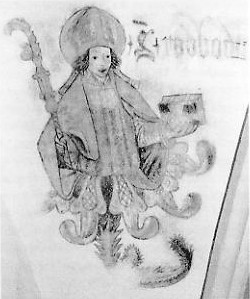Radboud of Utrecht
 From Wikipedia - Reading time: 6 min
From Wikipedia - Reading time: 6 min
This article needs additional citations for verification. (August 2008) |
Radboud | |
|---|---|
| Bishop of Utrecht | |
 Image of Bishop Radboud in the Broerenkerk in Zwolle | |
| Church | Catholic Church |
| Diocese | Archdiocese of Utrecht |
| In office | 900–917 |
| Personal details | |
| Born | before 850 |
| Died | 917 |
Saint Radbod (or Radboud) (before 850 – 917) was bishop of Utrecht from 899 to 917.
Life
[edit]Radboud was born around the middle of the 9th century from a noble Frankish family near Namur. His mother was of Frisian origin and a descendant of the Frisian king Radboud (died in 719). Radboud began his studies under the care of his maternal uncle Günther, Archbishop of Cologne, from 850 until his deposition in 863. After that Radboud continued his studies at the court school of the Western Frankish king Charles the Bald (843- 877), whose chaplain he became.[1] Much of his life was devoted to study and science.[2]
After Charles's death, he presumably became a Benedictine monk in the famous Saint-Martin convent of Tours. In 899 Radboud was elected bishop of the diocese of Utrecht with the permission of Emperor Arnulf of Carinthia (887-899). Because Utrecht was destroyed by the Normans, he did not live there but in Deventer[1] in the Oversticht, where one of his predecessors had settled.
As bishop, Radboud was the most important representative of East Frankish authority in the northern Netherlands. In 911, however, the Duchy of Lorraine, in which the diocese of Utrecht was located, came to the western Frankish kingdom. Radboud then seems to have wavered between loyalty to his old king or loyalty and connection with the new monarch. His most ancient biographical description criticizes him for the use of bishops in the East Frankish government, but this criticism may be the responsibility of the author. Around 914/915 he traveled to Rome where he presented a further unknown conflict with Count Meginhard of Hamaland to Pope John X (914-928); After having heard Radboud and representatives of Meginhard, the pope found a settlement.
Radboud made preparations to take the seat in Utrecht again. To do so, he drew up a list of all the possessions of the diocese before the expulsion by the Normans. Radboud fell ill on a mission trip in Drenthe and died in Ootmarsum in November 917 before these plans could be executed. He was buried in the Lebuïnuskerk, Deventer.[3]
He had appointed his successor, Balderik, himself.
Writings
[edit]A number of smaller writings are attributed to Radboud, but there are doubts about his authorship. Most of the writings are saints' lives, some in prose, others in verses. He described the life of the Anglo-Saxon missionaries Boniface (in prose), Suitbert and Lebuïnus (both in a sermon and in verses), as well as St. Amalberga (?) and Bishop Saint Servatius of Maastricht .
Veneration
[edit]He was buried in the Lebuin Church of Deventer. Several sources, including historian Johan Picardt, indicate that his intestines have been buried in the church in Nijenstede.[4] During the Middle Ages, the veneration of Saint Radboud remained limited to the diocese of Utrecht. His feast day is 29 November.[5]
Patronage
[edit]In the Netherlands, Radboud is the patron of Catholic scientific practice. In 1905, the St. Radboud Foundation was established with the aim of promoting Catholic higher education in the Netherlands and in particular the establishment of a Catholic university. In 1923 the Catholic University of Nijmegen was opened, in 1956 the associated Sint-Radboud hospital (now Radboudumc). On 1 September 2004, the university adopted the name Radboud University Nijmegen.[2]
References
[edit]- ^ a b "De heilige Radboud van Utrecht", Russian Orthodox Church, The Hague
- ^ a b Radboud Universiteit
- ^ "Radboud of Utrecht", The Medieval Liturgy of the Low Countries
- ^ Hesselink-Zweers, D., "Hardenberg, an episcopal castle fortified city", Hardenberg Municipal Archives
- ^ Roman Martyrology
Further reading
[edit]- F. Rädle, "Bischof Radbod von Utrecht", Die deutsche Literatur des Mittelalters: Verfasserlexikon, 2e ed.; dl. 7: 962-965 (with a survey of Radboud's published writings)
- B. Ahlers, Die ältere Fassung der Vita Radbodi (Frankfurt-Bern, 1976)
- M. Carasso-Kok, Repertorium van verhalende historische bronnen uit de Middeleeuwen (Den Haag, 1981); kritisch overzicht van aan Radboud toegeschreven werken (nrs. 8, 18, 52, 53, 62, 80, 88, 89, 352) en van de heiligenlevens over Radboud (nr. 75)
- Vita Radbodi/ Het leven van Radboud, explained, delivered and translated by Peter Nissen and Vincent Hunink (Nijmegen 2004)
- A. G. Weiler, "Sint Radboud, bisschop van Utrecht [Deventer] van 899/900 tot 917. Pastor, geleerde, historicus, dichter en componist", Trajecta, tijdschrift voor geschiedenis van het katholiek leven in Nederland; 12 (2003) 97-115
- René Veenman, "Radbouds Over de zwaluw", in: Madoc; 19 (2005): 194-203
 KSF
KSF